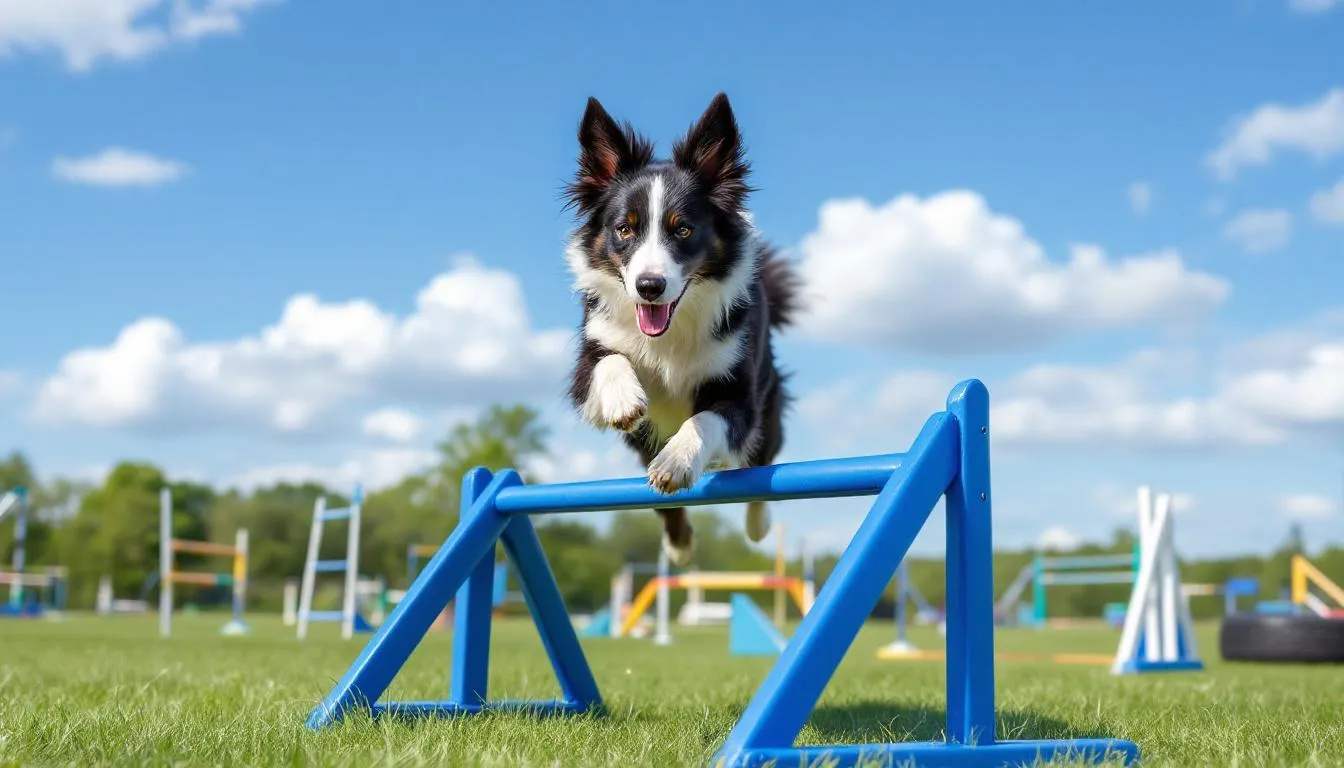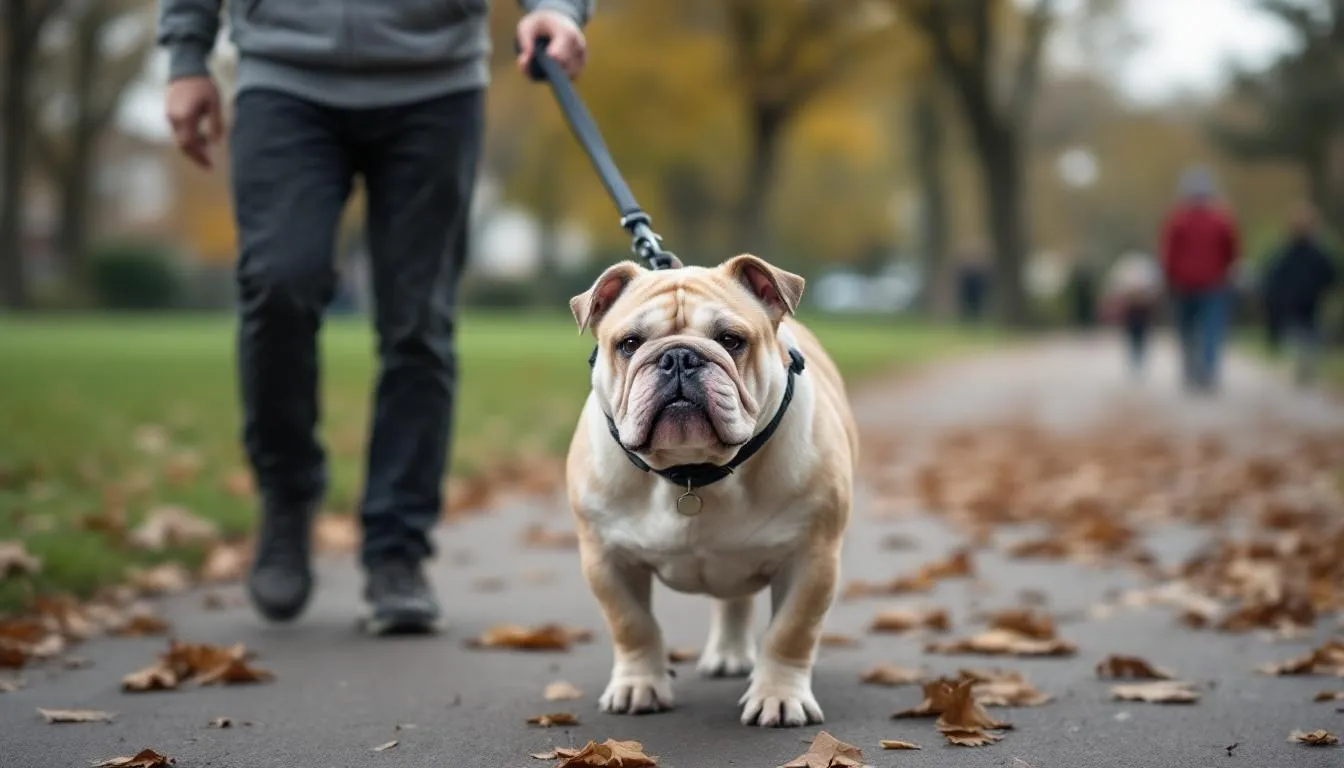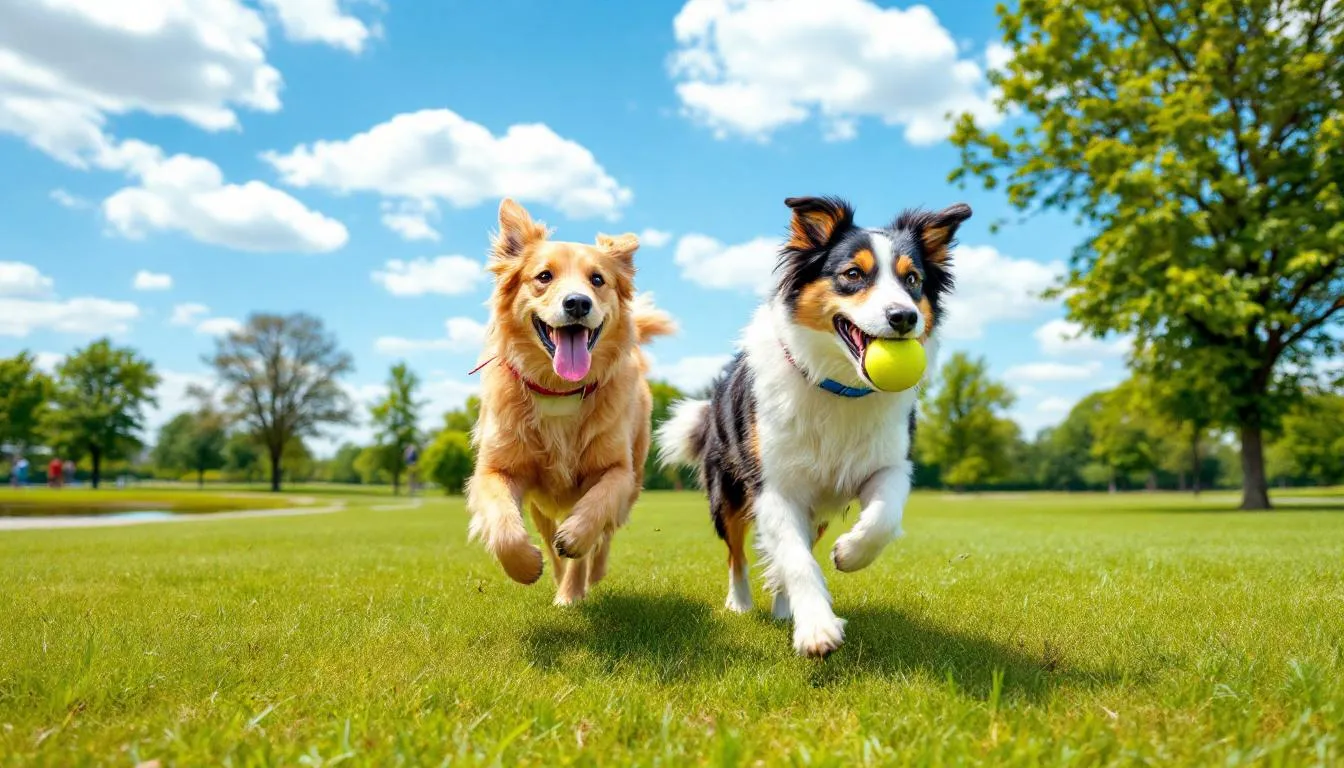Key Takeaways
- Most adult dogs need 30-60 minutes of daily exercise, but requirements vary significantly by breed, age, and health status
- Puppies require short, frequent play sessions rather than long walks to protect developing joints and bones
- Senior dogs benefit from gentle, low-impact activities like swimming and short walks broken into multiple sessions
- High-energy breeds like Border Collies and German Shepherds need 60-90 minutes of vigorous exercise daily
- Mental stimulation through training and puzzle games is equally important as physical exercise for your dog’s wellbeing
Most adult dogs need 30-60 minutes of daily exercise, but requirements vary significantly by breed, age, and health status
Puppies require short, frequent play sessions rather than long walks to protect developing joints and bones
Senior dogs benefit from gentle, low-impact activities like swimming and short walks broken into multiple sessions
High-energy breeds like Border Collies and German Shepherds need 60-90 minutes of vigorous exercise daily
Mental stimulation through training and puzzle games is equally important as physical exercise for your dog’s wellbeing
You love your dog and want them healthy and happy. But when your four legged friend starts chewing furniture, barking excessively, or bouncing off walls at bedtime, you might wonder: how much exercise does a dog need, really?
The truth is, there’s no universal answer. Your energetic Border Collie’s exercise needs differ drastically from your laid-back Basset Hound’s requirements. Getting this balance right isn’t just about tired paws—it’s about your dog’s physical health, mental wellbeing, and your sanity too.
Let’s break down exactly how much daily exercise your dog needs based on their age, breed, size, and health status. You’ll get practical, science-backed guidance that fits real life, not perfect scenarios.


Daily Exercise Requirements by Dog Age
Understanding how much exercise your dog needs starts with recognizing that requirements change dramatically throughout their lifetime. A bouncing puppy, athletic adult dog, and gentle senior dog each need completely different approaches to stay healthy.
Most pet parents make the mistake of treating exercise as a one-size-fits-all solution. But your dog’s developing bodies, peak fitness years, and aging joints require thoughtful adaptation. The key is matching physical activity to your dog’s current life stage while considering their individual health and energy levels.
Working with your veterinarian to create personalized exercise plans ensures you’re meeting your dog’s specific needs safely. This becomes especially important for dogs with health issues, but even healthy adult dogs benefit from professional guidance on exercise routines.
Puppy Exercise Needs (8 weeks to 18 months)
Puppies burst with energy, but their developing bodies need protection, not marathon training sessions. The general rule for puppy exercise is five minutes per month of age, twice daily. So your three-month-old puppy needs about 15 minutes of activity twice per day, not hour-long adventures.
Focus on short bursts of indoor play until your puppy completes full vaccination around 16 weeks. Hide and seek, gentle tug games, and basic training sessions provide both physical exercise and mental stimulation without stressing growing joints. These developing bodies can’t handle high-impact activities like jogging, jumping, or long hikes that might damage growth plates.
Incorporate socialization into your puppy’s exercise routine by introducing them to different surfaces, sounds, and controlled interactions with other dogs. A quick training session teaching “sit” or “come” counts toward their mental exercise quota while building important life skills.
Watch for signs your puppy is getting too much exercise: excessive panting, lethargy, or reluctance to continue playing. Puppies should end exercise sessions wanting more, not collapsed in exhaustion. Remember, developing bodies need twice as much rest as adult dogs.
Adult Dog Exercise Requirements (18 months to 7 years)
Healthy adult dogs hit their exercise prime during these years, requiring a minimum of 30 minutes daily for most breeds. High energy dogs and working breeds often need 60-90 minutes of varied physical activity to stay mentally and physically balanced.
The best exercise routine combines different activities: brisk walks for cardiovascular health, fetch or swimming for strength, and brain games for mental enrichment. This variety prevents boredom and works different muscle groups while keeping your dog active and engaged.
Building your dog’s exercise routine gradually prevents injuries and improves overall fitness. Start with your dog’s current activity level and add five to ten minutes weekly until you reach their target duration. Most dogs can handle more exercise than their owners think, but sudden increases often lead to sore muscles or joint problems.
Signs your adult dog needs more exercise include destructive behaviors, excessive barking, restlessness at night, and weight gain. Conversely, a well-exercised dog settles calmly at home, maintains a healthy weight, and shows good muscle tone. Regular exercise during these peak years sets the foundation for healthier senior years.
Senior Dog Exercise Needs (7+ years)
Senior dogs still need daily exercise to maintain muscle mass, joint flexibility, and mental health, but the approach shifts toward gentleness and accommodation. Aim for 30 minutes daily broken into shorter 10-15 minute sessions to prevent fatigue and joint stress.
Low-impact activities become crucial as your older dog may develop arthritis or other age-related conditions. Swimming provides excellent cardiovascular exercise without stressing joints, while slow walks on soft surfaces like grass or dirt trails are easier on aging paws than concrete sidewalks.

Watch for signs your senior dog is struggling: stiffness after exercise, reluctance to continue activities they once enjoyed, or excessive panting during previously easy walks. These signals suggest it’s time to adjust intensity, duration, or activity type.
Consider physical therapy options if your senior dog shows signs of joint pain or mobility issues. Many veterinary practices offer underwater treadmills, therapeutic massage, and other treatments that help maintain your dog’s quality of life while managing age-related changes.


Exercise Needs by Breed Type and Size
Your dog’s breed significantly influences how much exercise they need, often more than size alone. Understanding your dog’s breed background helps you provide appropriate physical activity and mental stimulation that satisfies their genetic programming.
Working breeds were developed for specific jobs requiring endurance, intelligence, and drive. Sporting breeds need activities that engage their retrieving and swimming instincts. Even toy breeds have exercise requirements, though they’re often met through indoor play and shorter walks.
Mixed breed dogs typically fall somewhere between their parent breeds’ requirements, but individual personality and energy levels matter more than genetics alone. Observe your dog’s behavior and energy patterns to determine if they’re getting enough exercise regardless of their breeding.
High-Energy Breeds
Border Collies, Australian Shepherds, and German Shepherds represent the marathon runners of the dog world, needing 60-90 minutes of vigorous daily exercise plus mental challenges. These working breeds become destructive and neurotic without adequate physical and mental stimulation.
Sporting breeds like Labrador Retrievers and Golden Retrievers thrive with swimming, fetch sessions, and activities that engage their retrieving instincts. A simple game of fetch in the backyard won’t cut it—these dogs need varied, challenging exercise that works both body and brain.
Terriers channel their hunting heritage through structured play and dog sports like agility or earthdog trials. Without proper outlets, these determined little athletes often redirect their energy toward digging, chasing, and other behaviors that frustrate dog owners.
High energy breeds excel at dog sports, advanced training, and activities that provide jobs for their active minds. Consider activities like hiking, jogging (for adult dogs), disc dog, or even tracking to keep these athletes satisfied and well-behaved.
Moderate Exercise Breeds
Most medium-sized mixed breeds and companion dogs fall into this category, needing 30-45 minutes of daily exercise that can be adapted based on weather, schedule, and available space. Breeds like Cocker Spaniels and Beagles benefit from varied walking routes that provide mental stimulation through new sights and smells.
These adaptable dogs do well with two walks daily plus some interactive play or training time. They’re content with neighborhood walks, visits to dog parks, and weekend hiking adventures without requiring the intense exercise needs of working breeds.
The key with moderate exercise breeds is consistency rather than intensity. A predictable routine of morning and evening walks, combined with mental enrichment activities, keeps these dogs physically fit and mentally satisfied.
Low-Energy and Special Needs Breeds
Brachycephalic breeds like Bulldogs, Pugs, and Shih Tzus require careful exercise management due to breathing difficulties. These flat faced breeds overheat quickly and struggle with intense physical activity, making short, gentle walks ideal during cooler parts of the day.
Giant breeds like Great Danes and Saint Bernards need low-impact exercise to protect their joints from the stress of carrying substantial body weight. Despite their size, these gentle giants often require less total exercise than medium-sized high energy dogs.

Small toy breeds often meet their exercise needs through indoor play, short outdoor walks, and mental stimulation activities. A brief walk around the block plus some indoor games typically satisfies most toy breeds’ daily exercise requirements.
Heat sensitivity becomes crucial for flat faced breeds during summer months. Exercise these dogs during early morning or evening hours, provide plenty of water, and watch for signs of overheating like excessive panting or difficulty breathing.
Large vs Small Breed Considerations
Larger breeds typically need more total exercise time but often prefer steady, moderate-intensity activities over high-intensity bursts. Their longer legs make them excellent walking and hiking companions once they reach physical maturity.
Small dogs often have bursts of high energy followed by rest periods, making multiple short exercise sessions more appropriate than single long walks. Their smaller strides mean they work harder to keep up during walks, so adjust pace and distance accordingly.
Joint health considerations differ between size categories. Large and giant breeds face higher risks of hip dysplasia and other joint problems, making low-impact exercise especially important. Small breeds may have luxating patella or other conditions requiring modified exercise routines.


Indoor vs Outdoor Exercise Options
Weather, living situation, and safety concerns sometimes make outdoor exercise challenging. Having both indoor and outdoor exercise options ensures your dog stays active year-round regardless of circumstances.
The best exercise routines combine both environments, using outdoor activities for cardiovascular fitness and space to run, while indoor options provide mental stimulation and weather-independent backup plans.
Outdoor Exercise Activities
Walking remains the foundation of most dogs’ exercise routines, providing cardiovascular fitness, mental stimulation through environmental exploration, and bonding time with dog owners. Vary your routes to keep walks interesting and provide new sights, sounds, and smells for mental enrichment.
Dog parks offer opportunities for off-leash exercise and socialization with other dogs, but they’re not suitable for every dog. Reactive dogs, poorly socialized dogs, or those with health issues may find dog parks stressful rather than beneficial. Always supervise your dog closely and be prepared to leave if situations become uncomfortable.
Swimming provides excellent low-impact exercise, especially beneficial for senior dogs or those with joint problems. Whether in natural bodies of water, dog-specific swimming pools, or even kiddie pools for small dogs, water exercise works muscles without stressing joints.
Building stamina for hiking or jogging requires gradual conditioning. Start with shorter distances and easier terrain, gradually increasing difficulty as your dog’s fitness improves. Always bring water for both you and your dog, and pay attention to paw pad condition on rough surfaces.
Indoor Exercise Solutions
Dog treadmills offer year-round cardiovascular exercise independent of weather conditions. Start slowly and use positive reinforcement to help your dog become comfortable with the moving surface. Never leave your dog unattended on a treadmill, and ensure they can exit safely.
Mental stimulation activities often tire dogs more effectively than physical exercise alone. Food puzzles, interactive toys, and training sessions provide mental exercise that’s especially valuable for intelligent breeds and during weather-restricted periods.
Create indoor obstacle courses using household items like chairs, broomsticks, and boxes. These makeshift agility courses provide physical exercise and mental challenges while strengthening the bond between you and your dog through collaborative play.
Stair climbing offers intense cardiovascular exercise for dogs living in multi-level homes. Start with a few trips up and down, gradually increasing repetitions. This high-intensity exercise is particularly useful for high energy breeds during bad weather.
Exercise for Dogs with Health Conditions
Dogs with health issues still need regular exercise, but their routines require careful modification to prevent injury or worsening of existing conditions. Working closely with your veterinarian ensures your dog gets appropriate physical activity while managing their specific health challenges.
The goal shifts from peak fitness to maintaining quality of life, mobility, and mental wellbeing within the constraints of your dog’s condition. Many health conditions benefit from modified exercise, making complete inactivity counterproductive for most dogs.
Arthritis and Joint Problems
Dogs with joint problems benefit enormously from low-impact exercise that maintains muscle mass and joint flexibility without causing additional stress. Swimming tops the list of ideal activities, providing cardiovascular fitness and muscle strengthening with minimal joint impact.
Physical therapy options like underwater treadmills combine the benefits of walking with the joint support of water buoyancy. Many veterinary rehabilitation centers offer these services, and some dog owners invest in home hydrotherapy equipment for regular use.
Pain management strategies allow many arthritic dogs to maintain active lifestyles. Anti-inflammatory medications, joint supplements, and alternative therapies like acupuncture can significantly improve your dog’s comfort during and after exercise.
Avoid high-impact activities like jumping, ball chasing that involves sudden stops and turns, and long runs on hard surfaces. Instead, focus on controlled walking, swimming, and gentle stretching exercises that maintain mobility without exacerbating joint pain.
Heart and Respiratory Conditions
Dogs with cardiovascular or breathing issues need carefully monitored exercise with frequent rest breaks and attention to early signs of distress. Short, gentle walks often work better than single longer sessions that might overtax compromised systems.
Recognizing signs of overexertion becomes crucial: excessive panting, blue-tinged gums, weakness, or reluctance to continue activity all signal the need for immediate rest. Some dogs benefit from supplemental oxygen during exercise, particularly those with severe respiratory compromise.
Consultation with veterinary cardiologists helps establish safe exercise parameters for dogs with heart conditions. Some cardiac patients benefit from mild exercise to improve circulation and maintain muscle tone, while others require strict activity restriction.
Weight Management Through Exercise
Obese dogs face a challenging cycle: they need exercise to lose weight, but excess weight makes exercise difficult and potentially dangerous. Start with very gentle, short activities and gradually increase duration and intensity as weight decreases.
Swimming and underwater treadmills offer ideal exercise for overweight dogs, providing cardiovascular benefits while supporting excess body weight. These low-impact activities allow longer exercise sessions without stressing joints and ligaments.
Combine exercise with dietary management for effective weight loss. Exercise alone rarely produces significant weight reduction in dogs, but it improves muscle tone, cardiovascular health, and mental wellbeing while supporting overall weight management efforts.
Exercise Tips for Busy Dog Owners
Modern life often conflicts with our dogs’ exercise needs, but creative solutions help ensure your dog stays active even during hectic periods. The key is efficiency and making exercise serve multiple purposes in your schedule.
Many dog owners find that exercising with their dogs improves both their own fitness and their pet’s wellbeing while strengthening their bond. This dual-purpose approach maximizes limited time while meeting everyone’s exercise needs.
Time-Saving Exercise Strategies
Combining your own fitness routine with your dog’s exercise needs creates efficiency while ensuring consistency. Many dogs make excellent jogging partners once they reach physical maturity and build appropriate stamina gradually.
Professional dog walkers and doggy daycare provide exercise solutions during work hours, though costs can add up quickly. Some dog owners form walking groups or arrange playdates with neighbors to share responsibilities and provide socialization opportunities.
Mental enrichment activities that require minimal owner involvement help busy schedules. Food puzzles, frozen Kong toys, and interactive games keep your dog busy while you handle other tasks, providing mental exercise that complements physical activity.
Weekend adventure planning compensates for weekday limitations by providing longer, more intensive exercise sessions. Hiking, beach visits, or extended play sessions help active dogs handle shorter weekday exercise routines.
Maximizing Limited Space
Apartment living doesn’t prevent adequate dog exercise with creative use of available space and nearby resources. Hallway fetch, stair climbing, and indoor agility courses provide physical activity regardless of yard size.
Utilizing nearby parks, walking trails, and dog-friendly businesses expands your exercise options beyond your immediate living space. Many cities offer off-leash areas, dog beaches, and hiking trails that provide space for more intensive exercise.
Safety Considerations and Warning Signs
Exercise safety protects your dog from injury while ensuring activities remain enjoyable and beneficial. Understanding potential risks and warning signs helps you adjust activities before problems develop.
Environmental factors like weather, surface conditions, and other animals all impact exercise safety. Preparation and awareness prevent most exercise-related injuries and emergencies.
Exercise Safety Guidelines
Hot weather poses serious risks, especially for flat faced breeds, senior dogs, and those with health conditions. Exercise during cooler morning or evening hours, provide frequent water breaks, and watch for signs of overheating like excessive panting or difficulty breathing.
Proper warm-up and cool-down procedures prevent muscle strains and joint injuries, particularly important for athletic dogs or those engaging in intense activities. Start with gentle walking before increasing intensity, and end sessions with calm walking rather than abrupt stops.
Leash safety and recall training enable safe off-leash activities while protecting your dog from traffic, wildlife, and other hazards. Practice recall in fenced areas before attempting off-leash exercise in open spaces, and always carry a leash for emergencies.
Monitoring for signs of heat exhaustion, dehydration, and overexertion helps prevent serious health emergencies. Excessive panting, drooling, weakness, or collapse require immediate veterinary attention and cooling measures.
Gradual Fitness Building
Sudden increases in exercise intensity or duration often lead to injuries like muscle strains, ligament tears, or stress fractures. Build your dog’s fitness gradually, increasing activity by no more than 10% weekly to allow tissues to adapt and strengthen.
Young adult dogs, particularly large breeds, face higher risks of ACL tears and other serious injuries during intense exercise. Avoid repetitive high-impact activities like ball chasing until growth plates close and muscles develop fully.
Surface conditions significantly impact injury risk. Soft surfaces like grass and dirt trails are easier on joints than concrete or asphalt, particularly important for dogs with existing joint problems or those building fitness after periods of inactivity.
FAQ
How do I know if my dog is getting enough exercise?
Watch for behavioral signs like destructive chewing, excessive barking, or restlessness, which often indicate insufficient physical activity and mental stimulation. A well-exercised dog should settle calmly at home, maintain a healthy weight, and show good muscle tone. If your dog still has excess energy after your current routine, gradually increase exercise duration or intensity.
Can I exercise my dog immediately after meals?
Wait at least 1-2 hours after feeding before vigorous exercise to prevent bloat, especially in large, deep-chested breeds like Great Danes and German Shepherds. Light walking is generally safe shortly after eating, but avoid running, playing fetch, or other intense activities that could cause stomach torsion.
What’s the difference between physical exercise and mental stimulation?
Physical exercise involves activities like walking and fetch that work your dog’s muscles and cardiovascular system, while mental stimulation includes puzzle toys, training sessions, and scent work that tire your dog’s brain. Both are essential for overall wellbeing, and mental exercise often tires dogs more quickly than physical activity alone.
How do I exercise a reactive dog safely?
Use quiet areas like empty parking lots or fields, focus on confidence-building activities indoors, and avoid crowded or triggering environments while working with a professional trainer. Early morning or late evening walks when fewer people and dogs are around can provide safe exercise opportunities. Mental stimulation becomes especially important for reactive dogs who may have limited safe exercise options.
Is it normal for my dog to sleep a lot after exercise?
Yes, dogs typically need 12-14 hours of sleep daily, and quality exercise should leave them pleasantly tired but not exhausted or showing signs of distress. Post-exercise napping is normal and healthy, but watch for excessive lethargy, difficulty breathing, or reluctance to eat or drink, which could indicate overexertion.
FAQ
How do I know if my dog is getting enough exercise?
Watch for behavioral signs like destructive chewing, excessive barking, or restlessness, which often indicate insufficient physical activity and mental stimulation. A well-exercised dog should settle calmly at home, maintain a healthy weight, and show good muscle tone. If your dog still has excess energy after your current routine, gradually increase exercise duration or intensity.
Can I exercise my dog immediately after meals?
Wait at least 1-2 hours after feeding before vigorous exercise to prevent bloat, especially in large, deep-chested breeds like Great Danes and German Shepherds. Light walking is generally safe shortly after eating, but avoid running, playing fetch, or other intense activities that could cause stomach torsion.
What’s the difference between physical exercise and mental stimulation?
Physical exercise involves activities like walking and fetch that work your dog’s muscles and cardiovascular system, while mental stimulation includes puzzle toys, training sessions, and scent work that tire your dog’s brain. Both are essential for overall wellbeing, and mental exercise often tires dogs more quickly than physical activity alone.
How do I exercise a reactive dog safely?
Use quiet areas like empty parking lots or fields, focus on confidence-building activities indoors, and avoid crowded or triggering environments while working with a professional trainer. Early morning or late evening walks when fewer people and dogs are around can provide safe exercise opportunities. Mental stimulation becomes especially important for reactive dogs who may have limited safe exercise options.
Is it normal for my dog to sleep a lot after exercise?
Yes, dogs typically need 12-14 hours of sleep daily, and quality exercise should leave them pleasantly tired but not exhausted or showing signs of distress. Post-exercise napping is normal and healthy, but watch for excessive lethargy, difficulty breathing, or reluctance to eat or drink, which could indicate overexertion.






